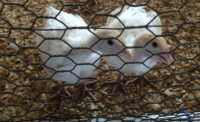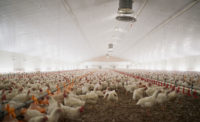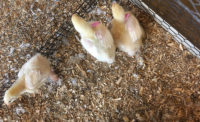As one of my earliest memories as a child, I remember going to Six Flags Great America, where I rode my first roller coaster. This coaster had back-to-back loops and I remember having that excited and frightened butterflies-in-my-stomach feeling as we zipped around the theme park.
Thrill-seeking and novelty is not specific to humans. In fact, many animals also display this curiosity toward unknown objects. In animal behavior, this concept is called the paradox of novelty. Meaning that although something is frightful, at the same time it is also intriguing, so the animal may pursue it.
In large animals, this same concept of thrill-seeking can be observed when placing an unopened bale of hay in a pen of pigs. The pigs will circle the bale, eventually open the contents and spread them all over the place, shredding the straw in the process and rolling around in the new bedding. Cattle may be hesitant about a plastic grocery bag whipping through a pasture at the mercy of the blowing wind but be so mesmerized by it that they will follow it until it leaves the paddock. This same paradox of fright and excite can also be observed in poultry species, although their behaviors to objects are very different than those observed in large animals. Birds have been imprinted with a natural behavior of pecking. This behavior is primarily used to aid in the parent’s regurgitation of nutrients in the wild. Research has shown that in some cases, it is color dependent. Others, it may be shape of the object or movement.
When walking through a commercial poultry operation amongst the birds, it reminds me of walking through a mall. There are more interactions than you can count between you and the surrounding shoppers, people you barely glance at. But we learn a lot from each other in passing based on our non-verbal social cues such as stature, walking pace or our facial cues. When trying to squeeze through a single door into the sale section at the same time as another shopper, do you apologize and let them get the last sale item, or do you glance and push yourself through the door harder to get there first?
These same interactions occur at the poultry level, with a submissive turkey allowing a more dominant turkey to eat from the feeder first or a dominant turkey giving a peck to the submissive to get them to move away from the feeding area. If two aggressive turkeys feel like fighting over who’s in charge, they may do so for several minutes by pecking at each other and having what appears to be a sibling’s squabble. One of the most powerful ways to develop an understanding of the paradox in poultry, however, is management-related handling since we, as animal caretakers, can also alter these behaviors.
Handling birds is necessary to assess the health status of the flock, to obtain accurate body composition and to determine the welfare of the animal by observing its features. In research settings, there are several types of behavioral tests that are completed to determine how to understand bird interactions with each other and how they perceive others, such as their caretakers. For instance, an emergence test can be conducted to determine how courageous a bird might be. In this test, a bird is placed in a small, enclosed box with a sliding door on it. The door is opened and the amount of time from when the door is opened until the bird emerges from the box is measured. On average, the first time the bird is exposed to this, they may be reluctant to emerge which has been historically recorded as fear.
However, if the bird was exposed to this procedure several times, after which they received a treat, the amount of time the bird would stay in the box would decrease. Another example of this repeated exposure to a stimulus is when a tom turkey is collected for artificial insemination purposes. The birds become accustom to the same individual for collection, so much, that in some cases, they may only produce for one individual caretaker. Environment has also been shown to effect bird behavior such as stocking density, day length or type of light. Aggression can be induced by several factors and it is part of my job to determine what causes these aggressive acts to occur.
There has been on-going research to determine if adding a novel object to pens will deter these animals from conducting aggressive acts toward each another and toward the new object. Research is still being completed to determine how a novel object can alter bird behavior because it can be influenced by several factors.
I strongly encourage the addition of novelty and enrichment into commercial poultry settings because these factors will allow birds to express normal pecking behaviors without increasing aggressive pecks toward one another. NP











